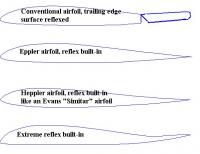

The camber line is not the mean line (mean between the points of face and back) it can coincide with it (therefore usually the confusion). If you drew a lot of circles, whoce center points are at the camber line, and whose radiuses were the amounts of thickness, then tangents to those circles would be the lines (would make up the curve) of the profile. Another way of presenting it, would be like picture no.2. (it usually converges after 3 or 4 iterations).Ģnd Edit: Replaced the picture with one which better shows how the thinkness is "drawn" onto the camber line (CL). After that you just repeat the second step of the procedure by drawing perpendicular lines onto that 2nd CL. Connect those, and that is your second iteration CL. After that you draw a lot of perpendicular lines, perpendicular to that CL, and find their midpoints between face and back (those points on face and back will no longer have same x values). You start by drawing a first camber line (CL) iteration through the midpoints (mean points) between the points of face and back at same x ordinates. Remember, since the thinkness is drawn perpendicular to the camber line, the position of camber line is not mean between the points of upper and lower line of profile (called the back and face of profile).Įdit (how this is done on paper): Uhh, painfully and in large scale (I'm talking long A0 paper here, that is 1189x5945mm on a large drawing desk. Method of interpolation through points can vary, but it doesn't matter, since I can always interpolate as many points as I need, so it comes to linear in the end. Now, I have a reverse problem - I have points of a profile, and I need to determine the position of the camber line. Thickness is always drawn perpendicular to the camber line(!), and that gives the profile points.

Second set of data is thickness at percentages of chord length. One is the position of mean camber line, given in the form of x,y where x is usually given in percentages of chord length. Usually, profiles are defined with two sets of data. Not in view of math but what would be the best way to take. One digit describing the distance of maximum thickness from the leading edge in tenths of the chord.I know this is a little outside your juridistiction, but I was wondering perhaps if you have time, if you could help me with one "procedure".One digit describing the roundness of the leading edge, with 0 being sharp, 6 being the same as the original airfoil, and larger values indicating a more rounded leading edge.
#AIRFOIL CAMBER CODE#
The following table presents the various camber-line profile coefficients:įour- and five-digit series airfoils can be modified with a two-digit code preceded by a hyphen in the following sequence:

The formula for the shape of a NACA 00xx foil, with "xx" being replaced by the percentage of thickness to chord, is y t = 5 t, Plot of a NACA 0015 foil generated from formula The 15 indicates that the airfoil has a 15% thickness to chord length ratio: it is 15% as thick as it is long.Įquation for a symmetrical 4-digit NACA airfoil The NACA 0015 airfoil is symmetrical, the 00 indicating that it has no camber. įor example, the NACA 2412 airfoil has a maximum camber of 2% located 40% (0.4 chords) from the leading edge with a maximum thickness of 12% of the chord.



 0 kommentar(er)
0 kommentar(er)
